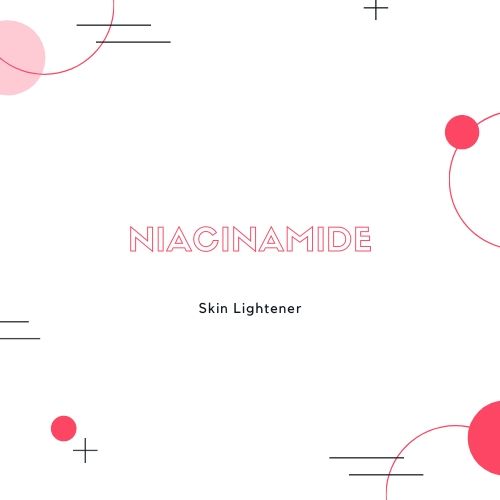(see also Function of Skin Barrier, What is Desquamation? What gives skin its colour? How is melanin formed in our body?)
Why is the skin lightening effect of Niacinamide so important?
Based on my research – reviewing the ingredient labels of 100+ skin whitening products, that are mainly made in India – I note that the number one ingredient that is used in these products is NIACINAMIDE. In this context, a product will have multiple skin lightening ingredients, and Niacinamide generally present in the largest quantity and it is also most prevalent.
Niacinamide is a cosmetic formulators dream ingredient as it is:
- Non-irritating (unlike e.g., Glycolic Acid or Lactic Acid or a retinoid),
- Well-tolerated by the skin,
- Easily formulated,
- Water soluble,
- Chemically stable, and
- Compatible with other formulation components.
This makes it ideal for cosmetic use…
Naturally, I am interested in Niacinamide mainly because of its skin lightening capability.
However, it would be remiss of me if I didn’t tell you how fantastic Niacinamide is for the skin. Importantly, the side-effects for Niacinamide are almost non-existent..
Today’s blogs are Part One (this blog), which will cover just the skin lightening ability of Niacinamide and Part Two, which covers other benefits of using topical Niacinamide.
What is Niacinamide?
Niacinamide is an active amide form of Vitamin B3 or Niacin. Vitamin B3 also takes the form of Nictonic Acid, but this has the side-effect of causing flushing (or vasodilation) and therefore, is not used in cosmetics.
Niacinamide is a white, odourless, water soluble solid/crystalline powder that is stable at pH of 6.
What foods contain Niacinamide?
The main dietary sources of Niacinamide are:
- Meats,
- Eggs,
- Milk,
- Nuts,
- Seeds,
- Legumes,
- Rice,
- Whole-grain,
- Fortified breads and cereals.
Why is Niacinamide so important to our bodies?
A deficiency in Niacinamide is (now) rare at least in developed countries. In extreme conditions, it causes a condition called pellagra (and you can look up the debilitating photos online).
If there is one thing you need to know about Niacinamide* is that it is vital for the formation of cofactors NAD and its phosphorylated derivative NADP.
NAD serves as a coenzyme in energy metabolism including glycolysis, the citric acid (Krebs) cycle, and fatty acid oxidation. The transfer of electrons from NAD formed in these processes to oxygen is the source of adenosine triphosphate (ATP) production in aerobic metabolism.
ATP is the major storage form of energy in cells.
This is how vital and essential Niacinamide is to our bodies.
Functions of Niacinamide and the evidence
There is abundant evidence supporting the functions/results of using Niacinamide below. Importantly, there is consensus on the studies and outcomes. In plain English, no-one disagrees with the outcomes I am discussing.
Function 1: Skin Lightening Effect
Hakozaki T et al (2002), set out to investigate the effects of 2% topical Niacinamide formulation on the formation of melanin (melanogenesis. See this BLOG), facial hyperpigmentation and skin colour on Japanese women, over a short 8 week period.
They found the following:
- Niacinamide has no impact on melanogenesis, especially on the rate-limiting enzyme tyrosinase. Instead Niacinamide downregulates the transfer of melanosomes from melanocytes to keratinocytes by 35% – 68%. Less melanin being transferred to the epidermis means lighter skin.
- Niacinamide significantly reduces the total area of hyperpigmentation and increased skin lightness. The size of the difference between vehicle and Niacinamide did not continue to increase after 4 weeks of treatment. The author noted that this plateau is not unique to Niacinamide but is also seen with other skin lightening ingredients, such as retinoids.
That may be the shortest note I write for a while. Right, I am off to write part 2!
Note: *Niacinamide, also known as nicotinamide, is the precursor of important cofactors niacinamide adenosine dinucleotide (NAD) and its phosphate derivative, niacinamide adenosine dinucleotide phosphate (NADP). These cofactors and their reduced forms (NADH and NADPH) serve as reduction-oxidation (redox) coenzymes in more than 40 cellular biochemical reactions (Levin et al 2010)
____
Sources and uses
Tanno O, Oya Y, Kitamura N et al. Nicotinamide increases bio-synthesis of ceramides as well as other stratum corneum lipids to improve the epidermal permeability barrier. Br J Dermatol 2000;143: 524–31.
Niren NM, Pharmacologic doses of Nicotinamide In the treatment of Inflammatory skin conditions: a review. Cutis (Jan. 2006), 77(1 Suppl):11-6.
Hakozaki T, Mlnwalla L Zhuang J el al. The effect of Niacinamide on reducing cutaneous pigmentation and suppression of melanosome transfer. Br. J Dermatol. (July 2002), 147 (1): 20-31
Gehring W, Nicotinic acid/Niacinamide and the skin J Cosmet Dermatol. 2004 Apr;3(2):88-93.
Shalita AR, Smith JG et al, Topical nicotinamide compared with clindamycin gel in the treatment of inflammatory acne vulgaris Int J Dermatol. 1995 Jun;34(6):434-7.
Soma Y, Kashima M et al, Moisturizing effects of topical nicotinamide on atopic dry skin. Int J Dermatol. 2005 Mar;44(3):197-202.
Bissett, D. L., Miyamoto, K. et al, Topical Niacinamide reduces yellowing, wrinkling, red blotchiness, and hyper pigmented spots in aging facial skin. Int J Cosmet Sci. 2004 Oct;26(5):231-8
Draelos ZD, Ertel K, Berge C. Niacinamide-containing facial moisturizer improves skin barrier and benefits subjects with rosacea. Cutis. 2005 Aug; 76(2):135-41
Biedermann, K., Lammers, K., Mrowczynski, E., Coombs, M., Lepp, C., El-Nokaly, M., and Burton, E., Regulation of sebum production by niacinamide, 60th Annual Meeting American Academy of Dermatology, New Orleans, 2002 J Cosmet Laser Ther. 2006 Jun;8(2):96-101.
Levin J et al How Much Do We Really Know About Our Favorite Cosmeceutical Ingredients? JCAD Online Editor | February 5, 2010
